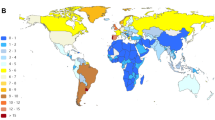Abstract
Urinary tract infections are among the most common infections seen in both the ambulatory inpatient and nursing facility settings. Due to unique characteristics of the geriatric population, including physiology, comorbidities, and social history, incidences of these infections increase with age requiring special attention. Here, we provide an overview of the etiology, diagnosis, treatment, and prevention of urinary tract infections with focus on the geriatric patient.
Similar content being viewed by others
References
Papers of particular interest, published recently, have been highlighted as: •Of importance •• Of major importance
Christensen KL, Holman RC, Steiner CA, Sejvar JJ, Stoll BJ, Schonberger LB. Clinical infectious disease. Infect Dis hosp US. 2009;49(7):1025–35.
Centers for Disease Control. Urinary tract infections. Available online at: http://www.cdc.gov/ncidod/dbmd/diseaseinfo/urinarytractinfections_t.htm
Litwin MS, Saigal CS, Beerbohm EM. The burden of urologic diseases in America. J Urol. 2005;173:1065–6.
Foxman B. Urinary tract infection syndromes: occurrence, recurrence, bacteriology, risk factors, and disease burden. Infect Dis Clin N Am. 2014;28(1):1–13. Provides recent review of epidemiolgic factors.
Tal S, Guller V, Levi S, et al. Profile and prognosis of febrile elderly patients with bacteraemic urinary tract infection. J Infect. 2005;50(4):296–305.
Perrotta C, Aznar M, Mejia R, Albert X, Ng CW. Oestrogens for preventing recurrent urinary tract infection in postmenopausal women. Cochrane Database Syst Rev. 2008;16;(2)
Raz R, Gennesin Y, Wasser J. Recurrent urinary tract infections in postmenopausal women. Clin Infect Dis. 2000;30:152–6.
Caljouw MA, den Elzen WP, Cools HJ, et al. Predictive factors of urinary tract infections among the oldest old in the general population. A population-based prospective follow-up study. BMC Med. 2011;9:57.
Nicolle LE. Urinary tract pathogens in complicated infection and in elderly individuals. J Infect Dis. 2001;183(1):S5–8.
Das R et al. Antimicrobial susceptibility of bacteria isolated from urine samples obtained from nursing home residents. Infect Control Hosp Epidemiol. 2009;30(11):1116–9.
Dairiki Shortliffe L, McCue J. Urinary tract infection at the age of extremes: pediatrics and geriatrics. Am J Med. 2002;113(1):55–65.
Routh JC et al. Increasing prevalence and associated risk factors for methicillin resistant Staphylococcus aureus bacteriuria. J Urol. 2009;181(4):1694–8.
Mody L, Juthani-Mehta M. Urinary tract infections in older women: a clinical review. JAMA. 2014;311(8):844–54. Provides recent insight into UTIs in older women.
Nicolle LE. Asymptomatic bacteriuria. Curr Opin Infect Dis. 2014;27(1):90–6. Addresses important clinical issue that is often overlooked in the treament of patients of all ages.
Nicolle LE et al. Infectious Diseases Society of America guidelines for the diagnosis and treatment of asymptomatic bacteriuria in adults. Clin Infect Dis. 2005;40(5):643–54. Provides concise guidelines that aid clinicians in reducing antibiotic overuse.
Juthani-Mehta M. Urinary tract infections in elderly persons, in online curricula: geriatric nephrology. 2009.
Kaye D et al. Asymptomatic bacteriuria in the elderly. Trans Am Clin Climatol Assoc. 1989;100:155–62.
Zalmanovici Trestioreanu A, Lador A, Sauerbrun-Cutler MT, Leibovici L. Antibiotics for asymptomatic bacteriuria. Cochrane Database Syst Rev. 2015;8:4. Recent publication.
Juthani-Mehta M et al. Clinical features to identify urinary tract infection in nursing home residents. J Am Geriatr Soc. 2009;57(6):963–70.
Boscia J et al. Pyuria and asymptomatic bacteriuria in elderly ambulatory women. Ann Intern Med. 1989;110:404–5.
Ouslander J et al. Pyuria among chronically incontinent but otherwise asymptomatic nursing home residents. J Am Geriatr Soc. 1996;44:420–3.
Kunin C. Urinary tract infections in females. Clin Infect Dis. 1994;18:1–12.
Deville W et al. The urine dipstick test useful to rule out infections. BMC Urol. 2004;4:4.
Nicolle LE. Urinary tract infection in geriatric and institutionalized patients. Curr Opin Urol. 2002;12(1):51–5.
Gupta K, Hooton TM, Naber KG, et al. International clinical practice guidelines for the treatment of acute uncomplicated cystitis and pyelonephritis in women: a 2010 update by the Infectious Disease Society of America and the European Society for Microbiology and Infectious Disease. Clin Infect Dis. 2011;52:e103–20.
American Geriatrics Society, American Geriatrics Society 2012 Beers Criteria Update Expert Panel. American Geriatrics Society Updated Beers Criteria for potentially inappropriate medication use in older adults. J Am Geriatr Soc. 2012;60:616–31.
Bains A, Buna D, Hoag NA. A retrospective review assessing the efficacy and safety of nitrofurantoin in renal impairment. Can Pharm J. 2009;142:248–52.
Williams EM, Triller DM. Recurrent acute nitrofurantoin-induced pulmonary toxicity. Pharmacotherapy. 2006;26:713–8.
Spring PJ, Sharpe DM, Hayes MW. Nitrofurantoin and peripheral neuropathy: a forgotten problem? Med J Aust. 2001;174:153–4.
Adverse Drug Reactions Advisory Committee. Hepatic toxicity with nitrofurantoin. Aust Adverse Drug Reac Bull. 2008;27:11.
Gu Q, Dillon CF, Burt VL. Prescription drug use continues to increase: U.S. prescription drug data for 2007–2008. CDC. National Center for Health Statistics Data Brief No. 42, September 2010. Available at:http://www.cdc.gov.ezproxy.cul.columbia.edu/nchs/data/databriefs/db42.pdf
Mody L, Crnich C. Effects of excessive antibiotic use in nursing homes. JAMA Intern Med. Epub June 2015. Recent publication.
Nicolle LE, Bradley S, Colgan R, Rice JC, Schaeffer A, Hooton TM. Infectious Diseases Society of America guidelines for the diagnosis and treatment of asymptomatic bacteriuria in adults. Clin Infect Dis. 2005;40(5):643–54.
Jepson RG, Williams G, Craig JC. Cranberries for preventing urinary tract infections. Cochrane Database Syst Rev. 2012;17:10. Comprehensive review.
Norwood DA, Parke CK, Rappa LR. A comprehensive review of potential warfarin-fruit interactions. J Pharm Pract. 2014 Aug 11. Recent publication.
Compliance with Ethics Guidelines
Conflict of Interest
Marissa C. Velez, Elisabeth M. Sebesta, and Kimberly L. Cooper declare that they have no conflict of interest.
Human and Animal Rights and Informed Consent
This article does not contain any studies with human or animal subjects performed by any of the authors.
Author information
Authors and Affiliations
Corresponding author
Additional information
This article is part of the Topical Collection on Geriatric Bladder Dysfunction
Rights and permissions
About this article
Cite this article
Velez, M.C., Sebesta, E.M. & Cooper, K.L. Lower Urinary Tract Infections in the Elderly. Curr Bladder Dysfunct Rep 10, 370–375 (2015). https://doi.org/10.1007/s11884-015-0329-0
Published:
Issue Date:
DOI: https://doi.org/10.1007/s11884-015-0329-0




